This article was written by guest-authors – Thea Chesney who is a Botanist with the Forest Service and Shane Hanofee is a Botany Technician and Chapter President of Redbud Chapter of the California Native Plant Society based in Grass Valley, CA.
Sierra Nevada Fungi Finds – Part 1
Warning: Mushrooms can be toxic when consumed! This is not a guide to edible mushrooms although some mushrooms are edible.
Are you excited for the onset of the mushroom season. Within, we cover some common and not-so-common species to be found in the sierras but most are found elsewhere as well.
First we set the stage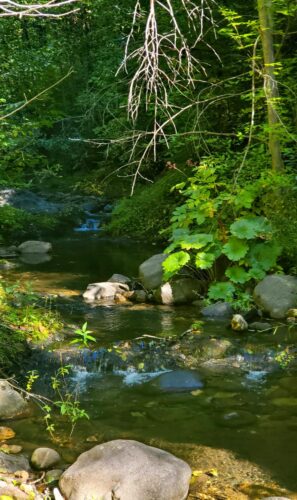

 with a sense of place. Most of these fungi were found ten feet or less from the edge of this creek. We were there to record a population of a very special fern that I had found here last year that had never before been seen in Nevada County, a relic population of a coastal species which has persisted here due to the aforementioned microclimate. Once the fern was collected for the herbarium, our plant-minds became mushroom-minds as we gorged ourselves on our first fungal sights of the fall season.
with a sense of place. Most of these fungi were found ten feet or less from the edge of this creek. We were there to record a population of a very special fern that I had found here last year that had never before been seen in Nevada County, a relic population of a coastal species which has persisted here due to the aforementioned microclimate. Once the fern was collected for the herbarium, our plant-minds became mushroom-minds as we gorged ourselves on our first fungal sights of the fall season.
Tricolored Mushroom
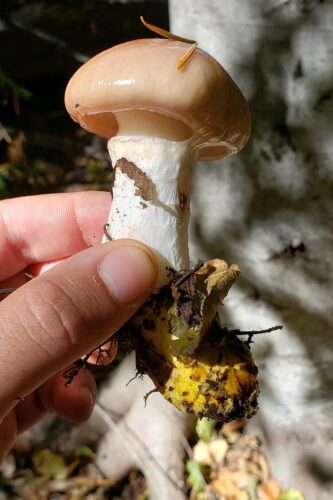


A tricolored mushroom with an eye-catching form and a brain-busting ecology, we have Gomphidius oregonense. Beneath that gloopy cap and slimy partial veil lie gills which will produce dark colored spores. But the gills are a lie! This is what we’d call a gilled bolete, in the sense that it is more closely related to the pored fungi we call boletes than to most gilled fungi. On top of that, this species is a parasite. Parasitic on a Suillus species. Suillus caerulescens to be precise. Now, Suillus are fleshy mushrooms with pores, a form best known from the family Boletaceae. However, Suillus are in a separate, closely related family, the Suillaceae. The Gomphidius pictured above is also in Suillaceae! Can you believe it? Preying on one’s own kin like a sociopath?
Giant Mammajamma
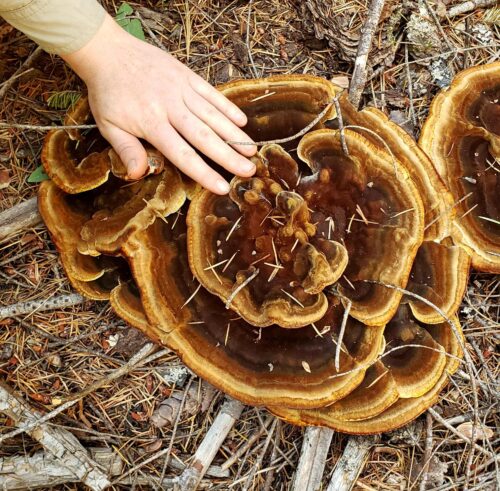


This giant mammajamma is a common sight in our area. It can always be found in conjunction with a dead or dying Douglas-fir tree, though sometimes it is quite far from the trunk in the case where it’s persisting off the declining roots. This is Phaeolus schweinitzii. And a fresh one to boot. If one were to shine a UV flashlight on this mushroom, one would find it fluorescent. That means it glows. On top of that, it’s commonly used as a myco dye, eliciting a broad spectrum of colors depending on various mordants, the age of the mushroom, and the pH of the dyebath. Recently, Sidnee Obersingleton, a talented Oregon mycologist, has been developing dyes and inks made from this mushroom that are ALSO FLUORESCENT! So this winter, when it’s pouring rain and you can’t go out, dye a little inside.
Fabric and Yarn
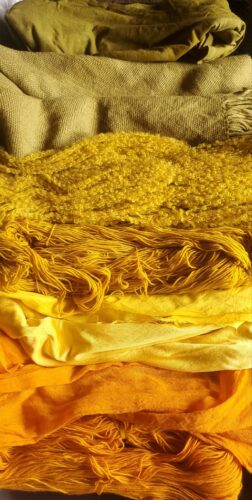


Fabric and yarn (silk and wool) dyed with young Phaeolus schweinitzii last week by Thea and a group of dedicated mushroom dyers. The greens are gotten with iron as a mordant, the golds with alum, and the bright yellows and oranges with tin. All with a neutral to slightly acidic pH. If you want to dye, it’s a good idea to brush up on your chemistry! Haven’t checked to see if any of these are fluorescent under UV, but the mordants seem to mute or kill the fluorescence in experiments I’ve seen. Mushroom dyers can find a community and much more information in the group Mushroom and Lichen Dyers United.
Xylaria hypoxylon
Xylaria hypoxylon, which is super common where there’s wet rotting wood in our area. It’s a tough little bugger, with fruitbodies that last a long time. Also not likely to be confused for another with the black and white coloration. Give one of those little fingers a flick and you may see white spores poof out from the tip. We usually spot this species when it is white and black, but it also has a stage in which it’s entirely black. The white stage and white spores are asexual, while the black spores produced in its all-black stage are sexual. Yep, fungi are weird and fungal sex and reproduction are complicated!
This seems like a good moment to point out that all of the mushrooms you’ve seen so far on this tour are basidiomycetes. This one is not. Basidiomycetes are one of the two main groups of fungi that produce mushrooms, and they produce their spores externally on the tips of cells called basidia (Get it? Basidia? Basidiomycetes?) Gilled mushrooms, boletes, puffballs, and most other familiar mushrooms are the fruiting bodies of basidiomycetes.
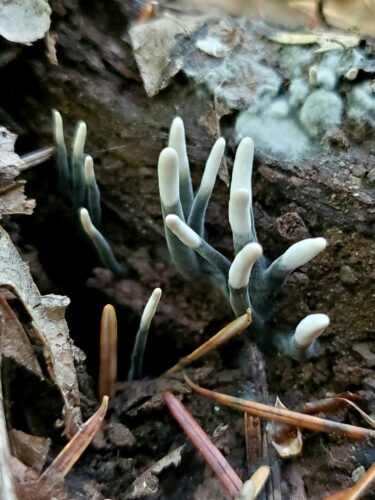


This Xylaria, as well as the cup fungus we’ll show you later, the ever-popular morels and highly prized (and priced!) culinary truffles, most lichen-forming fungi, and a wide array of cup, club, blob, and other less easily recognizable forms, are ascomycetes. This is the other major group of fungi that produces fruiting bodies that we can see. In ascomycetes, the sexual spores are produced inside cells called asci (Get it? Asci? Ascomycete?) Asci are generally narrow, tubular compartments in which spores develop in a vertical line, and there are several strategies for releasing the spores at maturity.
Note that we specified that it’s only sexual spores that are produced inside asci in ascomycetes, and this is also true of basidia in basidiomycetes. This means that the white, asexual spores on this Xylaria are produced by different structures called conidia. Yep, fungi are weird and fungal sex and reproduction are complicated!
Lactarius – Finely bumpy cap with a ruffly edge
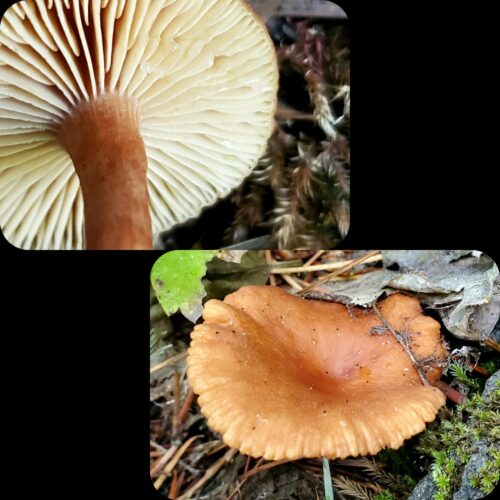


What’s this? Finely bumpy cap with a ruffly edge, watery latex emitted from the gills where broken, that SMELL?! We’ve got early October candy caps, Lactarius rubidus. A Canadian’s favorite fungus since they smell like maple syrup when dry! They also have a fragrance when fresh, but that’s more subtle and hard to describe. Once you train your nose to that, though, you’ll be able to identify this species with your eyes closed. This species provides a great example of multi-sensory ID techniques. Here, in addition to the visual characters, we’ve got smell and texture to help us out!
Lactarius
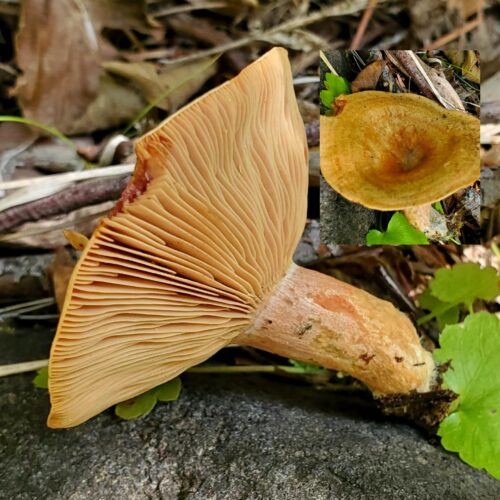

 Another Lactarius but this one is quite different. The latex is red, first of all, and a lot less runny. It’s bigger in size, and as you can see from the inset image, the cap is notably zonate. As in there are zones, concentric rings of color. If you see greenish tones here, that’s not a trick of the lighting, but rather the color that the latex eventually becomes after air exposure/tissue damage. A number of closely related local species of Lactarius have this color change characteristic, with orange or reddish latex to begin with. Rain- or frost-damaged specimens can show up mostly greenish. This is Lactarius rubrilacteus, or at least something in that species complex. Rubri- like red. -lacteus like milk. Hence the common name red-bleeding milkcap.
Another Lactarius but this one is quite different. The latex is red, first of all, and a lot less runny. It’s bigger in size, and as you can see from the inset image, the cap is notably zonate. As in there are zones, concentric rings of color. If you see greenish tones here, that’s not a trick of the lighting, but rather the color that the latex eventually becomes after air exposure/tissue damage. A number of closely related local species of Lactarius have this color change characteristic, with orange or reddish latex to begin with. Rain- or frost-damaged specimens can show up mostly greenish. This is Lactarius rubrilacteus, or at least something in that species complex. Rubri- like red. -lacteus like milk. Hence the common name red-bleeding milkcap.
Strobilurus trullisatus
These small white mushrooms fruiting in a cluster coming from the soil are about to show us why it’s so important to carefully dig out your mushrooms if you want to identify them.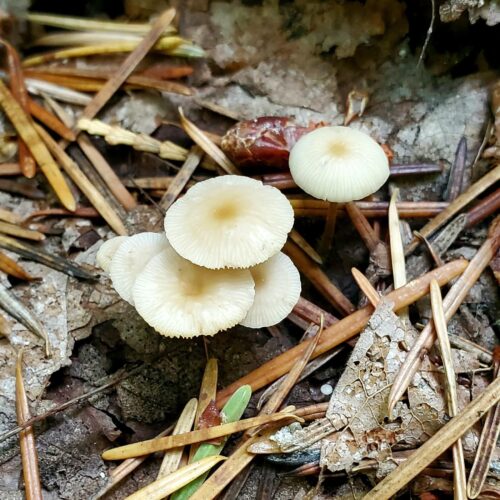


They aren’t growing from the soil at all! Clearly emerging from this Douglas-fir cone which was buried. This is one of the first mushrooms to be found each fall, requiring little moisture to pop up. Strobilurus trullisatus. Strobilurus species are mostly cone eaters and we have at least two other species here, each choosing a different host cone to fruit from. This species is always on Douglas-fir. S. diminutivus (which is truly tiny!) is often on sugar pine, but we don’t quite know yet if it can occur on any pine species or if it’s restricted to one or a group of species. 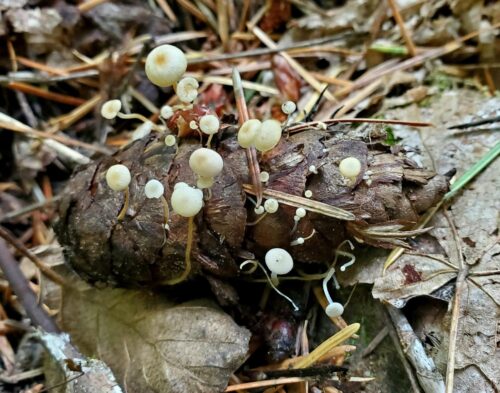


S. albipilatus, which despite its name (albi- meaning white, -pilatus referring to the cap) often has a gray cap, may be more of a generalist in terms of hosts and substrate, often occurring in mixed conifer twig and needle debris instead of on cones. There is almost certainly hidden diversity here, but at least we have a name for the Douglas-fir-dwelling one (for now).
Rhizopogon
Speaking of digging mushrooms, this one is hypogeous, which is a fancy word to mean that it grows entirely underground. Luckily for us, hypogeous fungi sometimes grow close enough to the surface that they just barely peek out, or form bumps in the litter that draw the eye of a careful observer. Occasionally a helpful squirrel digs one up and is scared off before it can consume its buried treasure. In these cases, we get a chance to peer at one.
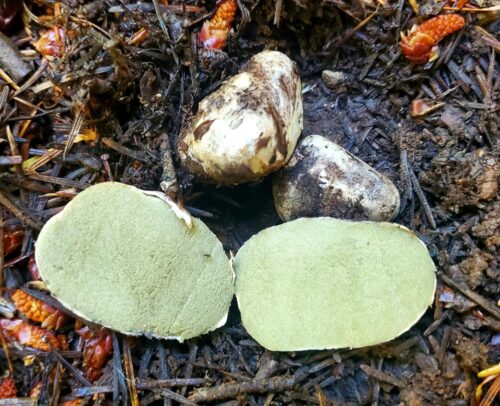

 This is a Rhizopogon sp. which are in the form group we call truffles, but they’re called false-truffles by some who distinguish between the “true truffles” of culinary import in the genus Tuber (and a few others) and the rest of the species that share the same general habit. Those “true truffles” are ascomycetes, but this Rhizopogon and many other truffle-y fungi are basidiomycetes, so this is a case of very distantly related organisms having developed a similar appearance and strategy for reproduction. Convergent evolution strikes again. That strategy for these guys? Become squirrel (or vole, or pig) food by smelling strong and irresistible to the digging diners, and make your spores tough enough to survive your target species’ digestive tract.
This is a Rhizopogon sp. which are in the form group we call truffles, but they’re called false-truffles by some who distinguish between the “true truffles” of culinary import in the genus Tuber (and a few others) and the rest of the species that share the same general habit. Those “true truffles” are ascomycetes, but this Rhizopogon and many other truffle-y fungi are basidiomycetes, so this is a case of very distantly related organisms having developed a similar appearance and strategy for reproduction. Convergent evolution strikes again. That strategy for these guys? Become squirrel (or vole, or pig) food by smelling strong and irresistible to the digging diners, and make your spores tough enough to survive your target species’ digestive tract.
It’s cut in half because inside lie the details we need to get to a species identification. Things like how thick the outside layer is, whether the flesh is marbled or not, what color the bruises are, and if you need to take some spores to a microscope, inside is where you’ll find them. If you post a truffle-form fungus here and want an idea and don’t cut it in half, guess what the first comment will ask you to do?
Ascomycota
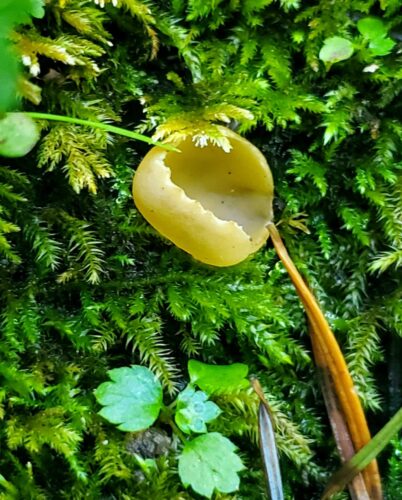


Here’s a small cup fungus growing on a mossy bank. We don’t know what it is yet. Maybe we never will. But we’re pretty sure it’s in the genus Peziza, which is a quite diverse assemblage of ascomycetes. In the center of the cup there are where the spores are borne, inside little structures called asci (Remember our introduction to ascomycetes?) Asci are these tubular compartments where ascospores develop and when they are mature, some open a little flap to let the spores out and others simply burst apart. The former are called operculate ascomycetes and the latter are the inoperculate ascomycetes. Peziza are operculate ascomycetes. And guess what. So are the Tuber, true truffles, we referenced earlier. This Peziza and those Tubers are in the same order, Pezizales. That Rhizopogon we pictured is in Boletales, meaning it’s more closely related to our slippery jack and bolete friends than to those truffles.
Suillus caerulescens
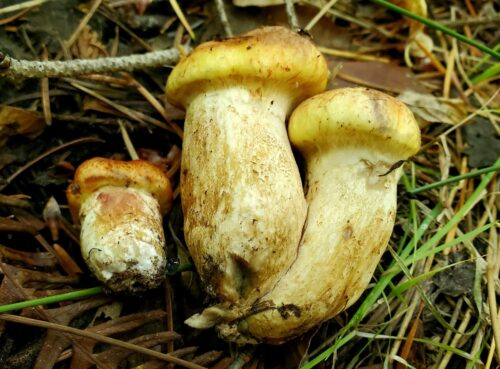

 We referenced this species earlier. This is Suillus caerulescens. This is the mushroom whose mycelium Gomphidius oregonense parasitizes. You won’t find the Gomphidius without the mycelium of the above mushroom present. But you may not find the mushroom itself since they don’t always fruit at the same time. S. caerulescens is pretty neat because it has a partial veil, still unbroken in this photo. Most genera of boletes don’t have veils, but some Suillus like this one have very prominent veils. And it also bruises blue, most reliably and noticeably towards the base of the stipe. The pores bruise red-brown. It’s a mycorrhizal conifer associate, with Douglas-fir.
We referenced this species earlier. This is Suillus caerulescens. This is the mushroom whose mycelium Gomphidius oregonense parasitizes. You won’t find the Gomphidius without the mycelium of the above mushroom present. But you may not find the mushroom itself since they don’t always fruit at the same time. S. caerulescens is pretty neat because it has a partial veil, still unbroken in this photo. Most genera of boletes don’t have veils, but some Suillus like this one have very prominent veils. And it also bruises blue, most reliably and noticeably towards the base of the stipe. The pores bruise red-brown. It’s a mycorrhizal conifer associate, with Douglas-fir.
Suillus
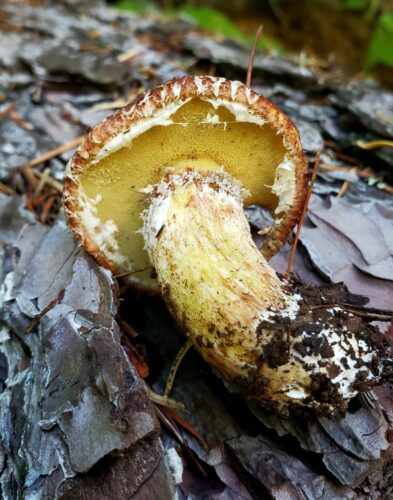

 Here’s a different Suillus, one that’s fairly closely related to S. caerulescens. Suillus lakei. Notice it’s much more shaggy and the cap is brown, not yellowish. You can see the partial veil, which has opened and lies in shreds near the cap margin and on the stipe. Some young S. lakei stems bruise blue too but not always. The pores bruise red-brown reliably, though. This species is also mycorrhizal with Doug-fir trees, so it’s not uncommon to find both species growing near each other. Oh, and this has a different Gomphidius partner/parasite, one not pictured although we did see it out there: Gomphidius subroseus, with a brighter pink cap and slightly less chunky build than G. oregonensis.
Here’s a different Suillus, one that’s fairly closely related to S. caerulescens. Suillus lakei. Notice it’s much more shaggy and the cap is brown, not yellowish. You can see the partial veil, which has opened and lies in shreds near the cap margin and on the stipe. Some young S. lakei stems bruise blue too but not always. The pores bruise red-brown reliably, though. This species is also mycorrhizal with Doug-fir trees, so it’s not uncommon to find both species growing near each other. Oh, and this has a different Gomphidius partner/parasite, one not pictured although we did see it out there: Gomphidius subroseus, with a brighter pink cap and slightly less chunky build than G. oregonensis.
Hygrophoraceae
This small fry growing from a clump of moss on a rock we haven’t yet figured out. It appears to be in the Hygrophoraceae, one of the waxy caps. It was just too cute and dainty not to include even though we don’t have an ID yet. Many of the waxy cap family are known to have some association with bryophytes or algae, but their exact relationship is often still a mystery. Are they parasites? Is there a mutualistic, proto-mycorrhizal relationship? From the location in which we found these, they definitely had something going on with the moss or with something microscopic that was with the moss, since there was no connection to any soil or other plants.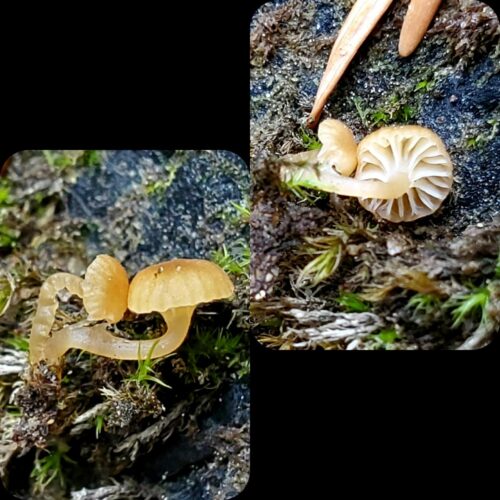


There’s a genus of mushrooms that looks a lot like this one, also in the family Hygrophoraceae, which is actually one of the few known cases of a basidiomycete lichen! That genus is called Lichenomphalia, and its members are associated with Coccomyxa algae. The vast majority of lichens have ascomycetes as the (primary) fungal partner, and they don’t look anything like this. As more research is done on the waxy cap family, we think that there may be more basidio-lichens or similar relationships discovered.
Pholiota
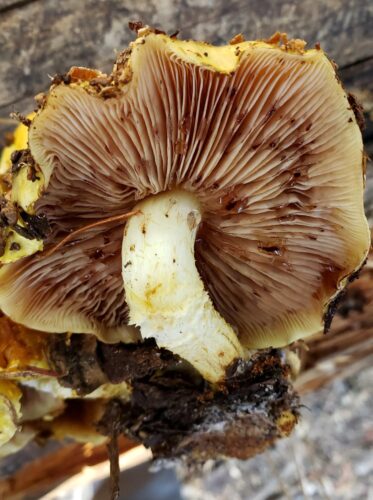


Here’s a wood rotter that often shows up in large clumps and clusters with scaly caps and spores in shades of brown. This is a Pholiota. We don’t know which one. There’s a lot of disagreement with the taxonomy of these and even semi-accepted circumscriptions require microscopy. Luckily, they’re pretty easy to learn to recognize at the genus level and, as with many mushrooms, that’s good enough for us. If you don’t like that we can’t put a name on everything we find, well, why don’t you go study mycology and help sort out these troubling groups? Lotta work to do and we need more people on the trail!
Gymnopus androsaceus
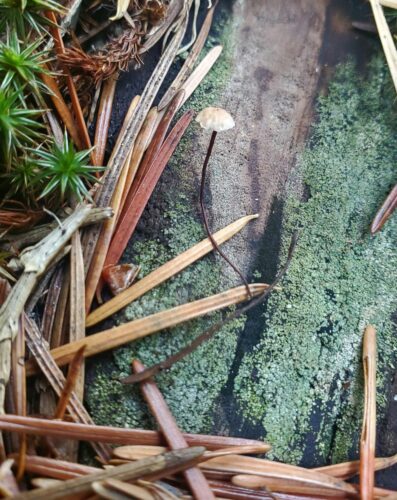


This tiny friend is Gymnopus androsaceus, which grows from conifer litter, here from Douglas-fir needles. So now we’ve covered fungi growing from Doug-fir needles, Doug-fir cones, one from dead or dying Doug-firs, and two that are mycorrhizal with their roots. God bless Pseudotsuga menziesii and the fungal bounty it harbors!
Coprinellus
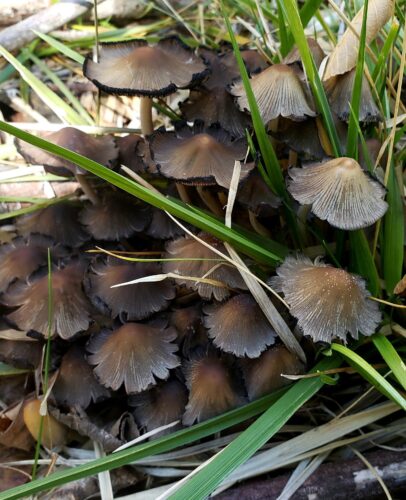


Already in early October, the fungi had been popping long enough for clusters of Psaths to have begun to disintegrate into black spores. Which is like at least a week! When I say it’s a Psath, I mean that it’s in the family Psathyrellaceae, which includes the genus Psathyrella but these are Coprinellus sp. In the complex that we used to lump under the name C. micaceus. They have these flecks on the cap that I guess early mycologists thought looked like mica flakes? This whole family needs some major revisions and few people care to work with them, despite their sheer commonality. I don’t blame them. They’re tough and you have to be a bit of a masochist to attempt that task.
Gymnopus fuscopurpureus
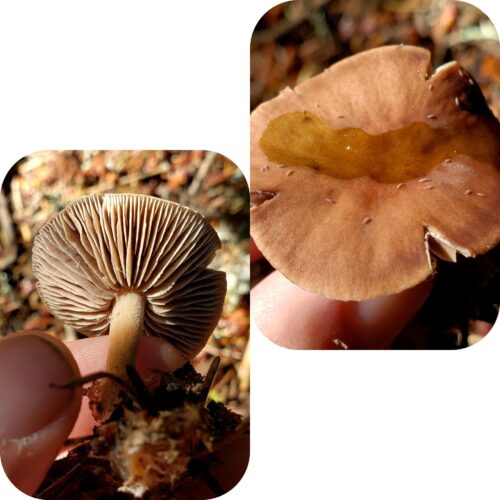


Here’s Gymnopus fuscopurpureus, which is a much larger cousin of the tiny Gymnopus we found on the doug fir litter. This one was confirmed by dropping a bit of KOH on the cap which stained the flesh a subtle green color which didn’t come out that well on camera. But you can see the chemical reaction on the cap above. These look like a darker, more purply version of the extremely common Gymnopus dryophilus with its light colors and lack of a green KOH reaction.
Xeromphalina
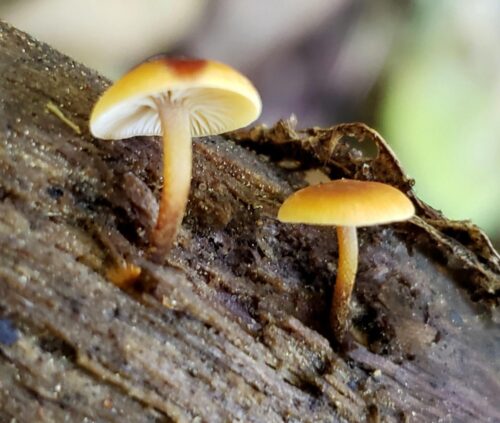

 Here’s a Xeromphalina species. I don’t know which one because those that occur on wood are not supposed to have a bitter taste AFAIK but this one did. But the stature, the dark colored stipe base, and especially that red KOH reaction, which can be seen on the cap to the left are all distinctive of the genus.
Here’s a Xeromphalina species. I don’t know which one because those that occur on wood are not supposed to have a bitter taste AFAIK but this one did. But the stature, the dark colored stipe base, and especially that red KOH reaction, which can be seen on the cap to the left are all distinctive of the genus.
Mycena haematopus
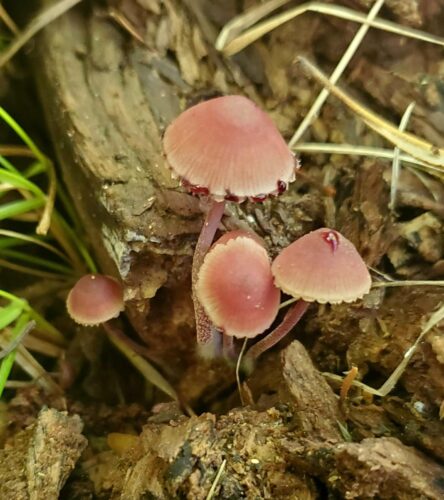


That’s not another KOH reaction on the cap there. That’s a blood-red exudate produced by the mushroom itself. In fact, that red latex and the frilly cap margin make this an easy identification in a group filled with tricky complexes and cryptic diversity. This is Mycena haematopus or the bleeding fairy helmet which is a name I like for the whiplash-inducing mishmash of violence and benevolence it references.
Entolomataceae
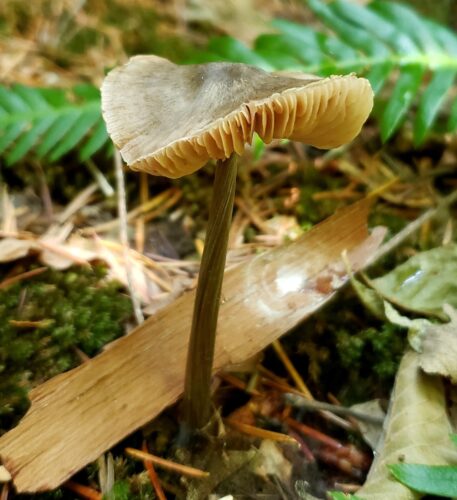


Another cryptic mushroom that we couldn’t get farther than the family (but didn’t try too hard either) It’s something in the family Entolomataceae as evidenced by the pink spores but this family is soooo hard that it’s difficult to will oneself to get into detailed work with them.
Rust – Pucciniastrum goeppertianum
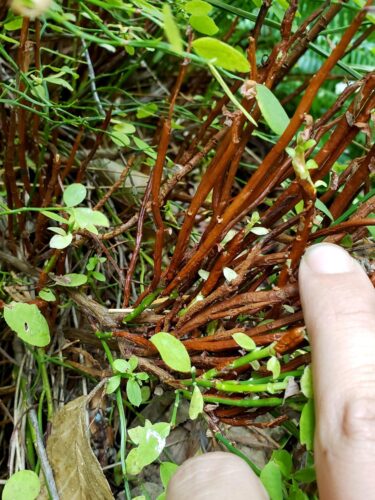


Leaving the traditional fungi forms for a second to talk rusts. Rusts are basidiomycetes (which you now know about) which infect plant tissues and sometimes cause some funky growths to occur. Like this here Pucciniastrum goeppertianum. Like most rusts, it hops around to two or more different species of plants during its complex lifecycle. Here it occurs on Vaccinium nevadense ssp nevadense but can occur on other vacciniums as well. Then it hops over to Abies spp to infect their needles and back and forth and back and forth. When it’s on Vaccinium it causes witches brooms, which are clusters of abnormal, dense branching and the typically green stems lose that coloration, becoming brown.
Rust
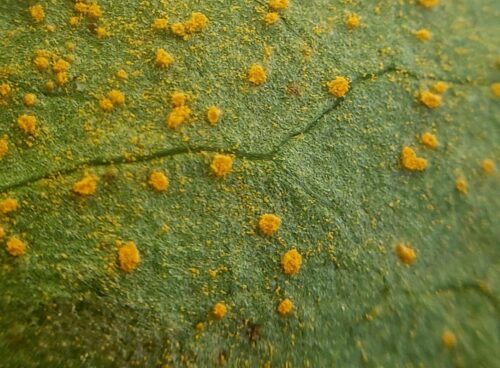


Here’s a different rust. I don’t know which. It occurs on the undersides of the leaves of Senecio triangularis, a wetland loving composite in the family Asteraceae. Included here to show some diversity. The orange coloration is common in most rusts. Those are the reproductive parts producing spores. Some rusts have as many as five different types of spores in their lifecycle and the name for the reproductive parts is dependent on which kind of spore is produced there, information I don’t have. The rust itself lives inside the living plant tissue, threading mycelium between the plant cells. Which is fascinating and only a little bit frightening. Don’t worry though. Rusts infect plants and plants only, so far *evil laugh*
Capitotricha
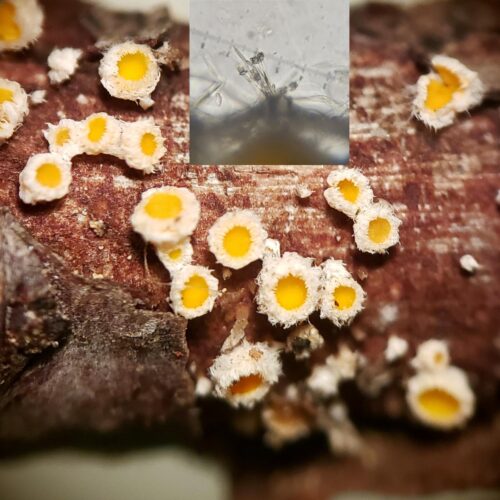


These are teeny tiny yellow cups with white hairy outsides occurring on wet wood. Each little cup is abount 1mm across to give you a sense of scale. Those white hairs on the outside are tipped in chunky crystals, which you can see in the inset image. This makes me think these are something in the genus Capitotricha. But since these weren’t mature enough to get spores from, my confidence is middling at best.
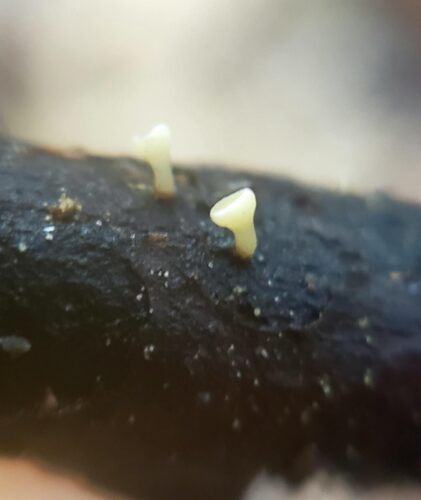


Here’s another mystery but isn’t it precious? A little white stalked cup growing on a wood so badly decomposed that I can’t tell where it came from. Some of the cups were darker colored. Again, they weren’t mature enough to get any good microscopic information from .
Tyromyces amarus
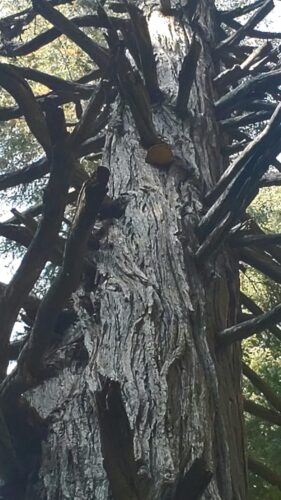


Yeah, yeah, it isn’t the greatest photo but it’s extremely difficult to photograph a mushroom occurring 100’ up in a mature incense cedar. That’s this species’ favorite place in the world. Way high along the trunk of an elder Calocedrus. This is Tyromyces amarus. Which is among my favorite fungi because of its relative rarity. I say relative because it may be more abundant than currently known, one doesn’t usually look for fungi by craning their necks to look high up in the trees. But since their preferred host is becoming rarer and rarer, they are still likely not as abundant as they once were and are threatened by our continuing ravaging of the forests.
Chloroscypha
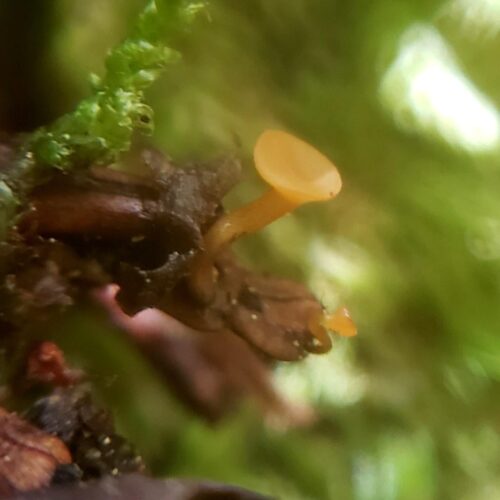


Yeah, yeah it isn’t the greatest photo but it’s extremely difficult to photograph a mushroom so very small. This one only grows on decaying incense cedar needles. And in the duff beneath a large incense cedar, it can be quite abundant. This is Chloroscypha. Which we would normally call C. alutipes but lately there’s been a question as to the precise species these incense cedar needle west coast mushrooms are. So, ever the taxonomic conservative, I go to genus only for now. Incense cedars are thought to have anti-fungal properties, and that may be true to an extent. Certainly they don’t host the same level of fungal diversity as the doug-fir. Incense cedars, like the rest of their cypress family relatives, don’t have mycorrhizal relationships with mushroom-forming fungi. But nonetheless, fungi always find a way and now you know about two fungi that not only consume incense cedar, but only incense cedar.
Shelf Fungus
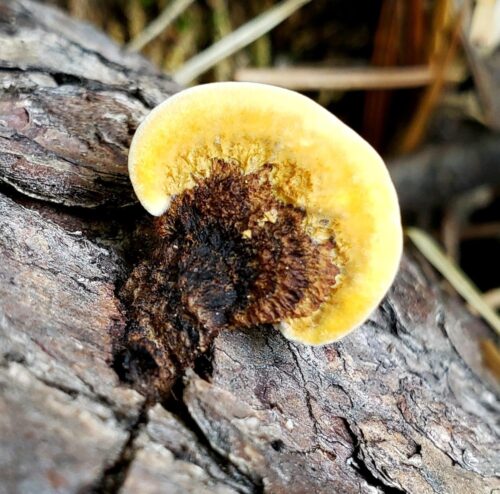


Here’s a shelf fungus with distinctly dark colors nearer the base. Most shelf fungi have pores on their underside but this one has gills. Except the gills are a LIE!! Technically it’s a folded hymenophore which only looks like gills. Hymenophore is just a fancy word for the fertile surface. This is something in the genus Gloeophyllum. Just another notch in the belt of convergent evolution presenting fungal forms that are nowhere remotely closely related to others with the same form.
Galerina marginata
We end with a run-in with death itself. There’s nothing inherently stopping me from popping just any mushroom in my mouth except for my knowledge and understanding of the existence of mushrooms like this Galerina marginata, the deadly galerina. (also maggots, lots of maggots in fungi) Technically, this is likely a species complex with multiple species yet to be teased out so calling it G. marginata may be jumping the gun. There’s no harm in handling one to confirm its identification and it is a rather attractive mushroom, if I say so myself. It’s got a partial veil and rusty-brown colored spores, an appressed hairy stipe and a glossy orange cap. All in all, a form that evokes the hallucinogenic Psilocybe and ill-informed psycho-nauts have poisoned themselves with this species, thinking they scored magical mushrooms. One telltale warning is its growth on wood, though it can occur on woodchips, like its psychedelic lookalike. Also lack of a bluing reaction and the spore color. In the Sierra, you’re very, very unlikely to find any magic mushrooms growing in the woods but this deadly one is super common.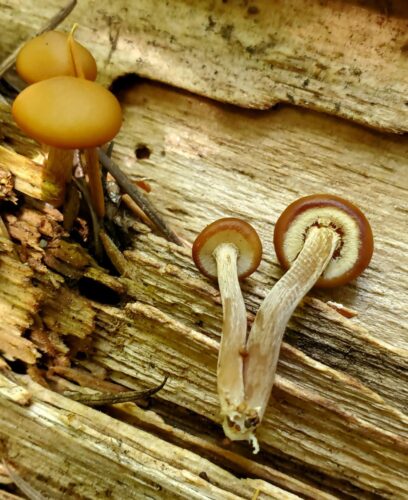


(Gal-er-EYE-nah mar-gin-AY-tah)
Anyway, that’s it! I want to sincerely thank anyone who read through to the end. Many signs are pointing towards us getting a good mushroom year after all after the shit-show that was last year. Knock on myceliated wood. Hope you found that entertaining and/or interesting.
See ya in the woods!
Editor’s Note: Want to learn more about local fungi? Shane and others post amazing pictures and give helpful insights for identification in a FB group called Sierra Nevada Mushroom ID and Ecology Forum. Let me know if you’d like to find out about more identification groups and foraging by messaging me through our SEG Facebook page. -Harry




